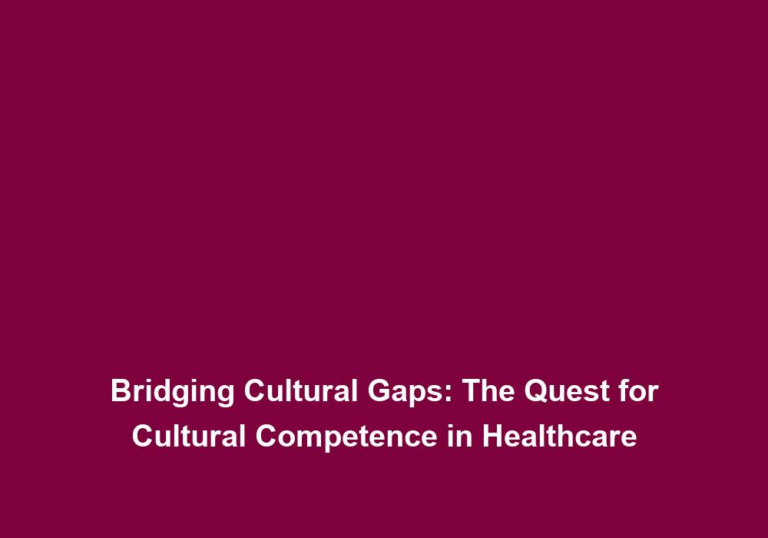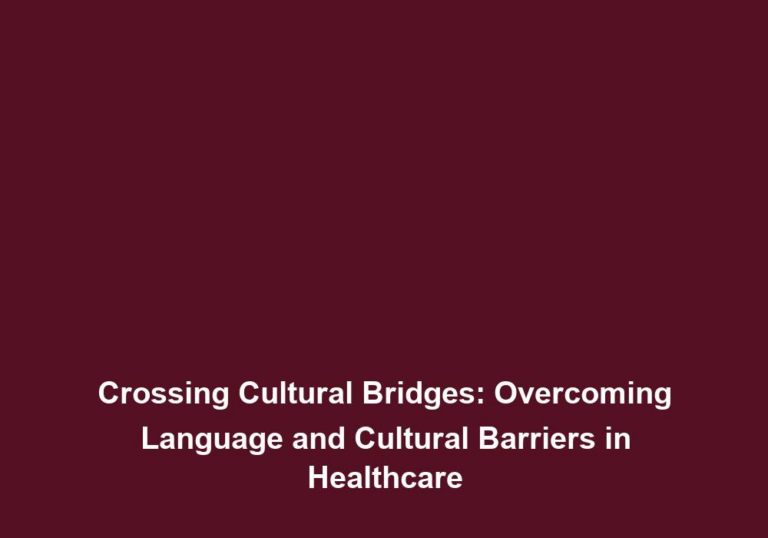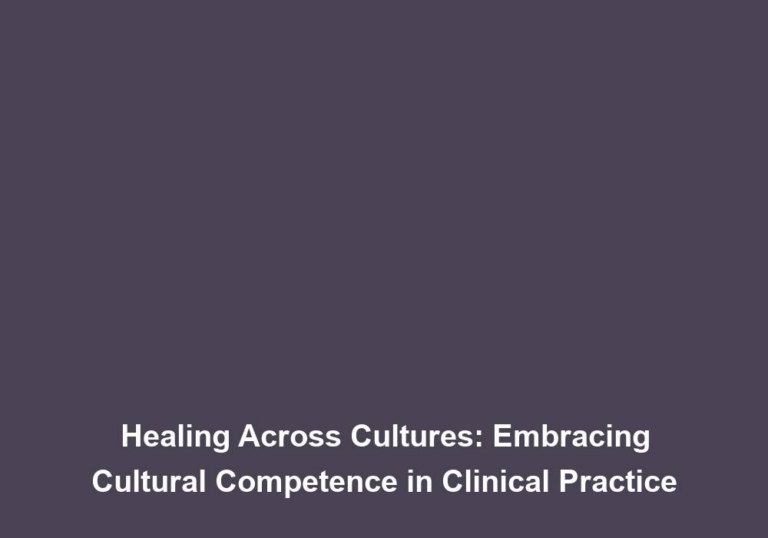Unity in Diversity: Embracing Multifaceted Patient Care
In the field of healthcare, the concept of unity in diversity holds immense significance when it comes to providing high-quality patient care. As our society becomes increasingly diverse, healthcare professionals must adapt and embrace the multifaceted nature of patient needs, backgrounds, and cultures. This article explores the importance of unity in diversity in patient care and provides valuable insights on how healthcare providers can effectively address the unique requirements of a diverse patient population.
Understanding the Concept of Unity in Diversity
Unity in diversity encompasses the idea that despite our differences, we are all connected and can work together harmoniously. In the context of healthcare, it means acknowledging and respecting the individuality and unique attributes of each patient, including their cultural, ethnic, religious, and socioeconomic backgrounds. By recognizing and embracing these diverse aspects, healthcare professionals can provide tailored care that meets the specific needs of each patient.
Unity in diversity is about recognizing and celebrating the richness that diversity brings to patient care. It is not merely about tolerating differences but actively seeking to understand and appreciate them. By doing so, healthcare providers can create an inclusive and culturally competent healthcare environment that fosters trust and promotes positive patient outcomes.
The Benefits of Embracing Diversity in Patient Care
- Enhanced Communication: Embracing diversity in patient care facilitates effective communication between healthcare providers and patients. When healthcare professionals understand and appreciate the cultural background and beliefs of their patients, they can better communicate and establish a rapport. This, in turn, leads to improved trust and patient satisfaction.
Effective communication is vital in healthcare settings, as it allows healthcare professionals to gather accurate and relevant information, understand the patient’s perspective, and provide appropriate care. By embracing diversity, healthcare providers can overcome language barriers, cultural norms, and other factors that may hinder effective communication. They can use language services, such as interpreters or translation services, to ensure that patients with limited English proficiency can fully express their needs and concerns.
- Increased Access to Healthcare: By embracing diversity, healthcare providers can bridge the gap between underserved populations and the healthcare system. Understanding the unique challenges faced by different communities can help tailor healthcare services to overcome barriers such as language, cultural norms, or lack of awareness.
Health disparities among diverse populations are a significant concern in healthcare. By actively embracing diversity, healthcare providers can identify and address these disparities. They can work collaboratively with community organizations and leaders to develop targeted healthcare initiatives that effectively address the health concerns of diverse communities. This can lead to improved access to healthcare services and better health outcomes for underserved populations.
- Cultural Competence: Embracing diversity encourages healthcare professionals to develop cultural competence, which is crucial for delivering patient-centered care. Cultural competence involves understanding and appreciating the values, beliefs, and practices of different cultures to provide appropriate and respectful care.
Cultural competence goes beyond simply being aware of cultural differences. It requires healthcare providers to actively learn about different cultures, their healthcare beliefs, and practices. This knowledge helps them tailor their care to align with patients’ cultural values and preferences, ultimately leading to better patient outcomes. Cultural sensitivity training plays a crucial role in developing cultural competence among healthcare professionals. It equips them with the knowledge and skills needed to understand and address the unique needs of diverse patient populations.
- Improved Health Outcomes: When healthcare providers embrace diversity, patient outcomes tend to improve. Tailoring care to a patient’s cultural and social context can lead to better treatment adherence, reduced health disparities, and improved overall health outcomes.
By understanding and addressing the unique needs of diverse patient populations, healthcare providers can ensure that their care plans are culturally appropriate and relevant. This can result in increased patient satisfaction, better treatment compliance, and improved health outcomes. Healthcare providers can achieve this by involving patients and their families in the care planning process, actively listening to patient preferences, and working collaboratively to develop care plans that align with patients’ cultural values and beliefs.
Strategies for Embracing Multifaceted Patient Care
- Cultural Sensitivity Training: Healthcare organizations should prioritize providing cultural sensitivity training to their staff. This training equips healthcare professionals with the knowledge and skills needed to understand and address the unique needs of diverse patient populations.
Cultural sensitivity training should cover a wide range of topics, including cultural awareness, communication skills, and strategies for providing culturally competent care. It should also emphasize the importance of self-reflection and self-awareness to recognize and challenge personal biases. By investing in cultural sensitivity training, healthcare organizations can ensure that their staff is well-prepared to provide quality care to patients from diverse backgrounds.
- Language Services: Access to language services, such as interpreters or translation services, is vital for effective communication with patients who have limited English proficiency. Healthcare providers should ensure that language barriers are not a hindrance to providing quality care.
Language barriers can significantly impact the quality of care provided to patients with limited English proficiency. By offering language services, healthcare providers can overcome these barriers and ensure effective communication. This includes providing interpreters or translation services during consultations, as well as developing translated materials and resources. Additionally, healthcare providers should be mindful of the need for clear and concise communication, using plain language and avoiding medical jargon when interacting with patients.
- Patient Education Materials: Developing patient education materials in multiple languages and formats can help healthcare providers effectively communicate important health information to patients with diverse backgrounds.
Patient education materials are valuable tools for empowering patients to take an active role in their healthcare. By developing materials in multiple languages and formats, healthcare providers can ensure that patients from diverse backgrounds have access to relevant and understandable health information. These materials should be culturally sensitive and take into account the literacy levels and preferences of different communities. Visual aids, videos, and interactive online resources can also enhance the effectiveness of patient education materials.
- Diversity in Staff: Promoting diversity within healthcare organizations is essential for embracing unity in diversity. Healthcare institutions should strive to have a diverse staff that reflects the communities they serve. This promotes cultural understanding, reduces bias, and enhances patient satisfaction.
Having a diverse staff brings a wealth of perspectives and experiences to healthcare organizations. It helps foster cultural understanding and empathy among healthcare professionals, enabling them to connect with patients from diverse backgrounds on a deeper level. Patients often feel more comfortable and understood when they see healthcare providers who share their cultural or ethnic background. To promote diversity, healthcare organizations can implement recruitment and retention strategies that prioritize the hiring and advancement of individuals from underrepresented communities.
- Collaborative Care Planning: In multifaceted patient care, involving patients and their families in the care planning process is crucial. Healthcare providers should encourage open dialogue, listen to patient preferences, and work collaboratively to develop care plans that align with patients’ cultural values and beliefs.
Collaborative care planning recognizes that patients are experts in their own healthcare experiences. By involving patients and their families in the decision-making process, healthcare providers can gain valuable insights into their needs, preferences, and cultural beliefs. This collaborative approach helps build trust, improves treatment adherence, and enhances patient satisfaction. Healthcare providers should actively listen to patients, ask open-ended questions, and provide clear explanations of treatment options to facilitate shared decision-making.
- Community Partnerships: Building strong partnerships with community organizations and leaders can help healthcare providers better understand the unique needs of different populations. This collaboration can lead to the development of targeted healthcare initiatives that effectively address the health concerns of diverse communities.
Community partnerships are essential for healthcare providers to gain a deeper understanding of the social determinants of health and the specific challenges faced by different populations. By engaging with community organizations and leaders, healthcare providers can identify community-specific health disparities, cultural practices, and barriers to care. This knowledge can inform the development of targeted interventions and initiatives that address the unique needs of diverse communities. Collaborative efforts can include health education programs, outreach events, and initiatives to improve access to healthcare services.
Conclusion
Unity in diversity is not just a concept; it is a fundamental principle that should guide healthcare providers in delivering optimal patient care. By embracing and celebrating the diversity within our patient populations, healthcare professionals can create an inclusive and culturally competent healthcare environment. Through strategies such as cultural sensitivity training, language services, and collaborative care planning, healthcare providers can ensure that every patient receives personalized care that respects their unique backgrounds and needs. Embracing unity in diversity is not only the right approach, but it also leads to improved patient outcomes and a more equitable healthcare system.






